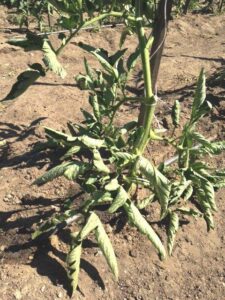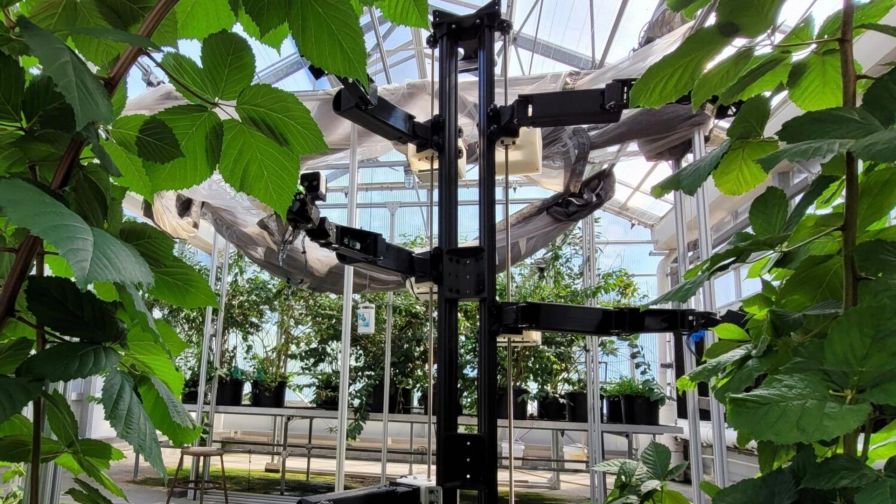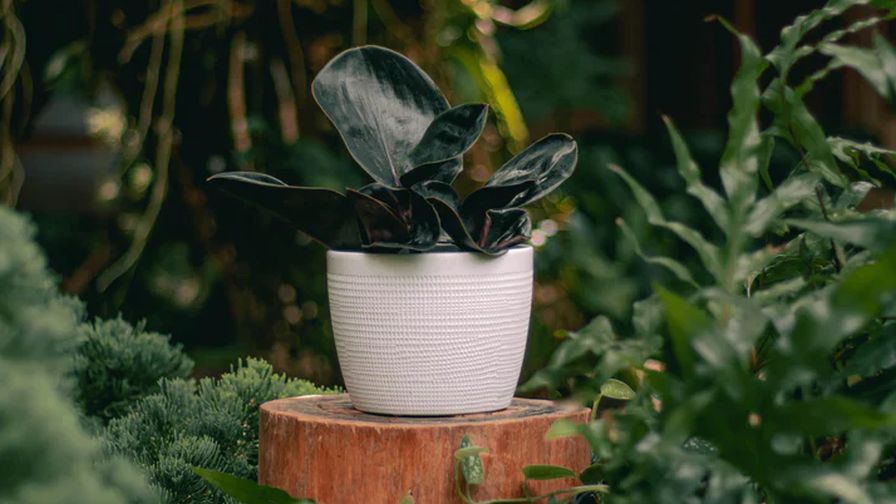Five Strategies for Thwarting Viruses in the Greenhouse

Curly top virus in tomato; Photo: UC, Davis
Plants are affected by a myriad of disease-causing agents, not the least of which is the virus. Unfortunately, viruses are incurable once a plant has been infected. Growers should take steps to prevent virus infection and have a plan to respond to an outbreak once it has occurred.
Select Resistant Varieties and Certified Virus-Free Plant Materials
The best way to deal with viral plant pathogens is to start with virus-free plant materials. When it comes to cuttings, some industry suppliers offer virus-indexed plant material, produced via tissue culture to eliminate viral pathogens from the plants. Another option is to start from seeds, since virus transmission via seed is quite limited. A third option is just emerging for horticulture: virus-resistant breeding. An early example of this type of breeding effort was in papaya, which helped save the Hawaiian papaya industry from papaya ringspot virus (PRSV) in the early 1990s. More recent introductions of virus resistant genetics include some vegetables and flowers.
Maintain a Clean Production Area
Hard surface sanitation is key to preventing the spread of virus amongst your crops. Viruses are carried by sap or leaf and stem trimmings and can remain viable on many hard surfaces. Between each production cycle, remove all debris and wash down production surfaces with cleaners and then sanitizers approved for virus sanitation. During production, sanitize scissors and pruners between each plant during trimming and other maintenance activities. Sanitizers list target pathogens on their labels; quaternary ammonium, hydrogen peroxide, and peracetic acid products are able to destroy certain viruses on contact.
Maintaining a clean production area goes beyond simply washing down hard surfaces. Insect feeding activity transmits a large number of viruses. Notably, aphids and thrips transmit viruses from a number of different virus families during their feeding activities. Growers should seek to prevent pest entry, control pest outbreaks, and eliminate weeds and debris that can serve as food sources and hiding places for insects. Weeds can also act as reservoirs for viruses due to wide viral host ranges.
Quarantine New or Suspicious Plants
Utilization of quarantine is essential to the prevention of disease outbreaks. New plant material entering the facility should always be quarantined for inspection prior to entering the main production area. Scout for signs of disease, be it viral, bacterial, or fungal. Aggressively treat insect stowaways, as insects are able to transmit a number of different viruses through feeding activity.
Scout Frequently for Common Virus Symptoms
Recognizing viral symptoms is a key component to scouting and avoiding a viral outbreak. Unfortunately, many viruses can infect multiple plant species and most crops are susceptible to more than one type of virus. Given this, growers should familiarize themselves with some common signs of viral infection.
- Mottling, ringspot, or mosaic patterns – Mosaic viruses can cause an uneven, mottled appearance in leaves, with alternating dark and light green areas. These mosaics can be random across the leaf surface or in specific patterns. Some mosaic viruses result in circular or spiral patterns on leaf surfaces. Not all mosaic viruses are detrimental – Tulip breaking virus causes dramatic color variations in tulip flowers and was responsible for the Dutch “tulip mania” of the 17th century.
- Distorted foliage or necrotic spots – Viruses such as Tomato Spotted Wilt Virus (TSWV) Potato Virus Y, or Impatiens Necrotic Spot Virus (INSV) can cause a wide range of damage symptoms, such as wilting, necrotic spots, stunting, and even stem death.
Some of the symptoms described above can be confused with damage from abiotic causes, such as spray burns and wind damage. The key is to study the pattern across the crop. Virus symptoms will generally appear slowly in small areas of the crop. Abiotic damage will appear more suddenly and often be more widespread.
Utilize On-site Testing to Confirm a Diagnosis
Ultimately, testing is the only way to confirm a diagnosis. On-site testing technology is continuously improving. Lateral flow test devices have been widely in use since 1945, being further refined and patented by 1988. Most of the general public has been exposed to this technology at one point or another, most recently in the form of at-home COVID-19 rapid tests. Agdia offers easy to use lateral flow devices, such as the ImmunoStrips, that are capable of quickly testing plant material for the presence of specific viruses. For example, if a grower suspects TMV to be present in their crop, a TMV-specific ImmunoStrip may be ordered and utilized to test suspicious plants.
To Save or to Destroy?
Once suspicious symptoms have been recognized and infection confirmed, growers may take one of two routes. Depending on crop and point in production, growers may simply choose to immediately destroy suspicious plants. Care must be taken to prevent additional spread of infective plant material. Avoid handling plants as much as possible. Infected plants should be bagged in place, pot and all, to prevent spreading the disease while moving infected plants through a healthy crop. Discard plastic bags outside the greenhouse, far away from the production area.
For growers with high-value crops or rare genetics, viral infection can be remediated through the use of tissue culture. While virus particles replicate within pretty much any plant cell, they are passively transported throughout the plant using the vascular system. Tissue culture tries to get ahead of this transport by excising very tiny samples from meristematic tissue, theoretically before the vascular system is fully developed and before virus particles enter that tissue. Full plants are then grown from these samples, hopefully free of any viral contaminants.
Top plant viruses and dates of characterization
- Tobacco mosaic virus (1930)
- Tomato spotted wilt virus (1930)
- Tomato yellow leaf curl virus (1950s)
- Cucumber mosaic virus (1934)
- Potato virus y (1931)
- Cauliflower mosaic virus (1980)
- Impatiens necrotic spot virus (1989)
- Plum pox potyvirus (1933)
- Beet curly top virus (1974)
- Hops latent viroid (1987)










